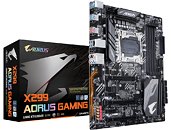- Joined
- Oct 9, 2007
- Messages
- 47,511 (7.48/day)
- Location
- Hyderabad, India
| System Name | RBMK-1000 |
|---|---|
| Processor | AMD Ryzen 7 5700G |
| Motherboard | ASUS ROG Strix B450-E Gaming |
| Cooling | DeepCool Gammax L240 V2 |
| Memory | 2x 8GB G.Skill Sniper X |
| Video Card(s) | Palit GeForce RTX 2080 SUPER GameRock |
| Storage | Western Digital Black NVMe 512GB |
| Display(s) | BenQ 1440p 60 Hz 27-inch |
| Case | Corsair Carbide 100R |
| Audio Device(s) | ASUS SupremeFX S1220A |
| Power Supply | Cooler Master MWE Gold 650W |
| Mouse | ASUS ROG Strix Impact |
| Keyboard | Gamdias Hermes E2 |
| Software | Windows 11 Pro |
Intel created quad-core "Kaby Lake-X" processors for its latest HEDT platform as they provide an affordable entry to the segment, with a potential to upgrade to larger 6-core, 8-core, 10-core, 12-core, 16-core, and even 18-core processors. The two "Kaby Lake-X" SKUs launched are merely adaptations of the Core i7-7700K and i5-7600K for the LGA2066 socket, as they feature just 256 KB of L2 cache per core (and not 1 MB per core of "Skylake-X"), just a dual-channel DDR4 controller, even though the socket supports quad-channel memory; and just a 16-lane PCIe (while the platform supports up to 44 lanes). While the Core i7-7740X and i5-7640X are priced more or less on par with their LGA1151 twins, motherboards on this platform aren't cheap, with the cheapest LGA2066 motherboard priced a little over $200. GIGABYTE senses an opportunity in all this, in launching the Aorus X299 Gaming. This LGA2066 motherboard only supports the i7-7740X and i5-7640X, and no other LGA2066 Core i7 or Core i9 chip.
Built in the ATX form-factor, you could be mistaken for thinking the Aorus X299 Gaming to be a mainstream-desktop motherboard based on the Z270 chipset, were it not for the unmistakable LGA2066 socket. The board features four DDR4 DIMM slots, all towards the east of the socket, and so it only supports up to 64 GB of dual-channel DDR4 memory. On boards with four DDR4 slots, yet quad-channel memory support, you typically find the memory slots split in groups of two, on either sides of the CPU socket. This "Kaby Lake-X" specificity carries over to even the PCI-Express slots, where there's only one slot with full x16 wiring, the second slot only features x8 wiring, while the third slot is x4. You can use up to two graphics cards in multi-GPU, where the first and second x16 slots configure as electrical x8/x8.




Keeping in mind that the board will only cater to 112W TDP "Kaby Lake-X" chips, GIGABYTE went easy on its electricals. The board draws power from a 24-pin ATX, and only one 8-pin EPS. Power is conditioned for the CPU using an 8-phase VRM with high-current chokes. Storage connectivity includes two 32 Gb/s M.2 slots, and eight SATA 6 Gb/s ports. The rear I/O lacks any display connectors, and gives you the feel of being on a high-end desktop platform, which lacks onboard graphics. USB connectivity includes two USB 3.1 gen 2.0 ports (both on the rear panel), and ten USB 3.0 ports (six on the rear panel, four by headers).
You get a high-grade onboard audio solution, which combines a Realtek ALC1220 8-channel HDA CODEC (120 dBA SNR), with ground-layer isolation, gold-plated audio jacks, and WIMA and Nichicon audio-grade capacitors. The sole networking option is a gigabit Ethernet interface, driven by an Intel i219-V controller. The board features a number of RGB LED headers driven by GIGABYTE RGB Fusion software. Available now, we expect the board to command a sub-$200 price.
View at TechPowerUp Main Site
Built in the ATX form-factor, you could be mistaken for thinking the Aorus X299 Gaming to be a mainstream-desktop motherboard based on the Z270 chipset, were it not for the unmistakable LGA2066 socket. The board features four DDR4 DIMM slots, all towards the east of the socket, and so it only supports up to 64 GB of dual-channel DDR4 memory. On boards with four DDR4 slots, yet quad-channel memory support, you typically find the memory slots split in groups of two, on either sides of the CPU socket. This "Kaby Lake-X" specificity carries over to even the PCI-Express slots, where there's only one slot with full x16 wiring, the second slot only features x8 wiring, while the third slot is x4. You can use up to two graphics cards in multi-GPU, where the first and second x16 slots configure as electrical x8/x8.




Keeping in mind that the board will only cater to 112W TDP "Kaby Lake-X" chips, GIGABYTE went easy on its electricals. The board draws power from a 24-pin ATX, and only one 8-pin EPS. Power is conditioned for the CPU using an 8-phase VRM with high-current chokes. Storage connectivity includes two 32 Gb/s M.2 slots, and eight SATA 6 Gb/s ports. The rear I/O lacks any display connectors, and gives you the feel of being on a high-end desktop platform, which lacks onboard graphics. USB connectivity includes two USB 3.1 gen 2.0 ports (both on the rear panel), and ten USB 3.0 ports (six on the rear panel, four by headers).
You get a high-grade onboard audio solution, which combines a Realtek ALC1220 8-channel HDA CODEC (120 dBA SNR), with ground-layer isolation, gold-plated audio jacks, and WIMA and Nichicon audio-grade capacitors. The sole networking option is a gigabit Ethernet interface, driven by an Intel i219-V controller. The board features a number of RGB LED headers driven by GIGABYTE RGB Fusion software. Available now, we expect the board to command a sub-$200 price.
View at TechPowerUp Main Site
Last edited:




